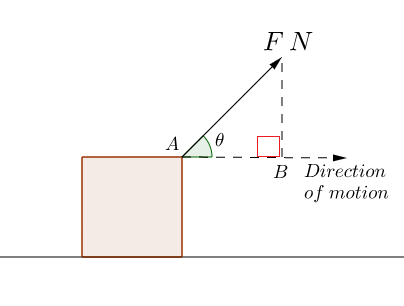Forces applied at an angle (Mechanics)
Forces applied at an angle
Suppose that an object is being dragged across a surface by a force of magnitude $F$. The object moves horizontally and the angle between the force and direction of motion is $\theta$.

The component of the force in the direction of motion is the length of the line $AB$. Using the rule for a right-angled triangle cos $\theta = \frac{adjacent}{hypotenuse}$ the length of $AB$ is $F \times \cos \theta$. Resolving the force in the direction of motion is finding this value. Note: $\theta$ is the angle between the the force and the direction - not always the angle given.
Worked Example: Finding the component of the force
In the $x$-direction
Suppose that a particle is being dragged along a surface by means of a force of magnitude $16 \mathrm{N}$. The angle between the force and the $x$-direction is $35^{\circ}$. What is the component of the force in the $x$-direction?
Solution
We have that $\theta = 35^{\circ}$ therefore \begin{align} \text{Component in the }x \text{-direction} & = F \cos \theta, \\ & = 16 \times \cos (35^{\circ}), \\ & = 13.106 \mathrm{N} \text{ (3 d.p.).} \end{align} Note that your calculator must be in degrees.
In the $y$-direction
Suppose that a particle is being dragged along a surface by means of a force of magnitude $7 \mathrm{N}$. The angle between the force and the $x$-direction is $60^{\circ}$, however the force is acting below the horizontal. What is the component of the force in the $y$-direction?
Solution
We have that $\theta = (90 + 60)^{\circ} = 150^{\circ}$ because we measure $\theta$ as being the angle between the force and the direction, where here the direction is the positive $y$-axis. Therefore \begin{align} \text{Component in the }y \text{-direction} & = F \cos \theta, \\ & = 7 \times \cos (150^{\circ}), \\ & = -6.062 \mathrm{N} \text{ (3 d.p.).} \end{align} Notice here that the force is negative - this is because it is acting in the opposite direction to the positive. Here, we could use $\theta = (90 - 60)^{\circ} = 30^{\circ}$ then change the sign of our answer from positive to negative and get the same result.
Test Yourself
Try our Numbas test on forces at an angle: Forces at an Angle